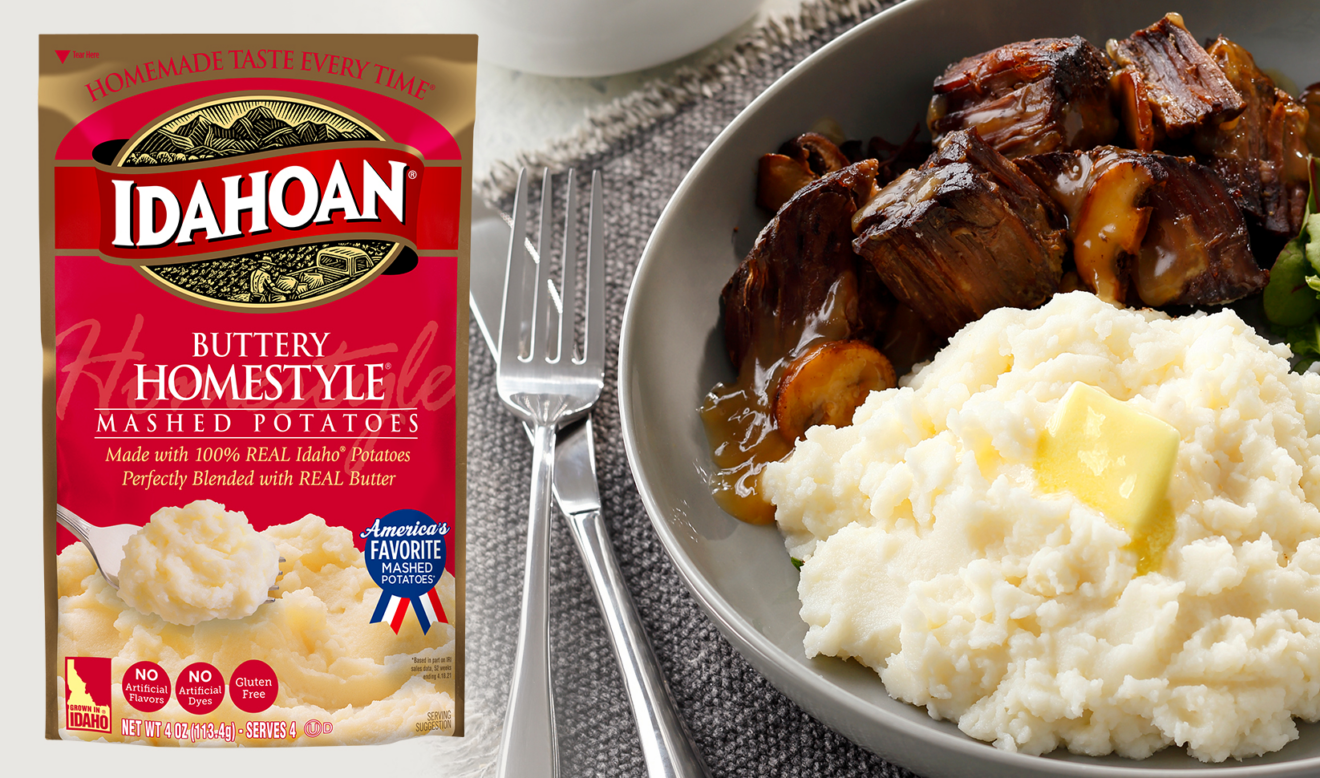This post is sponsored by Idahoan Foods.
The pandemic has drastically changed the way consumers cook and shop for food – driving demand for versatile pantry staples and accelerating online grocery shopping. These changes are forcing manufacturers and retailers to innovate. Idahoan Foods has risen to the challenge by launching a direct-to-consumer e-commerce site and updating its marketing approach to speak to the way consumers are cooking today. In this interview, Idahoan Foods Director of E-commerce Chuck Coyle and Vice President of Retail Marketing and Business Development Ryan Ellis discuss how the company balances its growing e-commerce sales with traditional retail. They also share advice on how consumer packaged goods companies can best market their products and serve their customers in today’s evolving marketplace.
Idahoan launched its direct-to-consumer site in March 2020 – right at the beginning of the pandemic that brought a flood of new consumers to online grocery ordering. What has the consumer reception of the DTC site been like, and what do you think are the key factors in its success?

Coyle: Back when grocery store shelves couldn’t be replenished fast enough and consumers were staying inside as much as possible, our DTC site was welcomed with open arms. In fact, the initial surge in orders was lightyears ahead of what we had planned for. We made it a priority to be available for our customers during such an unprecedented time, and everyone from senior leadership to the crew leading fulfillment rallied to help get orders out. Since then, consumer response has continued to be very positive. Our quick and easy prep offers the convenience that consumers love and search for. We like to look at the DTC site as a chance to surprise and delight Idahoan fans by engaging directly with our consumers. Our e-commerce orders are sent out quickly and often include fun surprises like recipe cards and stickers. The site has unique offerings only available online, such as a build-your-own variety pack for our Flavored Mashed Potatoes line. Subscriptions are also available at a discount and are highly customizable.
What are some of the biggest challenges food and beverage brands face with e-commerce, and what is your advice to other brands for overcoming these hurdles?
Coyle: By and large, the main logistical challenges food and beverage brands face with e-commerce are related to forecasting. Unpredictability is a major hurdle with forecasting that relates to shipping, warehousing and keeping up with demand. The ability to be nimble – scaling production up and down as needed – as well as being strategic in the amount of safety stock kept on hand both help mitigate these challenges. It’s also important to ensure consistency across the digital shelf. Idahoan has seen success in creating a centralized repository of digital assets and content which can easily syndicate out to all our e-commerce partners. E-commerce within the CPG industry has seen exponential growth over the last two years. With continued growth and evolution, it will be increasingly important to capitalize on innovations and new capabilities to capture value and best serve consumers.
What strategies is Idahoan using to retain current customers and attract new ones as the popularity of online grocery shopping grows?
Coyle: One of our main strategies is ensuring Idahoan products are easily discoverable through keywords and product placements on our partners’ sites, while reinforcing key points of differentiation. We’ve executed directed digital marketing tactics for quite some time now, and these efforts support both traditional retail and e-commerce. Whether we’re activating on social media – through owned channels and with influencers – or utilizing purchase decision targeted ads, we’re able to appeal to both existing Idahoan fans and potential new customers.
Idahoan worked with IRI to survey consumers about how they engage with Idahoan products. What were the key findings of this survey and how have they influenced Idahoan’s sales and marketing strategies?

Ellis: Historically, we had always considered Idahoan products to be part of the “packaged potatoes” category. We assumed that when consumers think about Idahoan, they’re comparing our offerings to other convenience-driven potato products. Within that category, we’ve been able to boast overwhelming market share and we know the quality of our products makes them stand out. However, this study we did with IRI caused us to reframe how we think about our products in the marketplace. We learned that consumers aren’t deciding between us and other convenient potato products. Instead, they think about what side dish they’re going to put on the dinner plate. Then, they choose between Idahoan and offerings like quick-prep rices, pastas or stuffings. We’ve set our sights higher, and now consider our competitive set to be “quick-prep starch sides.” This insight has informed how to best market to consumers, including over 4 million new households our company added during the pandemic.
As director of e-commerce at Idahoan Foods, Chuck Coyle is responsible for all things e-commerce including pure play accounts like Amazon, grocery pickup and delivery, and has launched Idahoan’s own direct-to-consumer website. Since his start with the company in 2019, Chuck has helped guide Idahoan’s exponential e-commerce growth during this unique time as customers and consumers have shifted more of their shopping behavior to digital sales channels.
In his current role as the vice president of retail marketing and business development at Idahoan Foods, Ryan Ellis is a member of the senior leadership team. He oversees all elements of marketing, including product launches, e-commerce, creative, social and digital, branding and PR, as well as business development and consumer programs for the brand’s full product portfolio. Since Ellis joined Idahoan Foods in 2012, under his stewardship, the company has seen a 50-point gain in retail brand share and 20-point gain in household penetration in the US. Ellis is also leading Idahoan’s international business in the UK, which has gained share leadership over three years.
